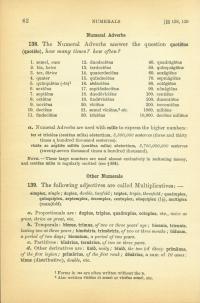138. The Numeral Adverbs answer the question quotiēns (quotiēs), how many times? how often?
| 1. semel once | 12. duodeciēns | 40. quadrāgiēns |
| 2. bis twice | 13. terdeciēns | 50. quīnquāgiēns |
| 3. ter thrice | 14. quaterdeciēns | 60. sexāgiēns |
| 4. quater | 15. quīndeciēns | 70. septuāgiēns |
| 5. quīnquiēns (-ēs)1 | 16. sēdeciēns | 80. octōgiēns |
| 6. sexiēns | 17. septiēsdeciēns | 90. nōnāgiēns |
| 7. septiēns | 18. duodēvīciēns | 100. centiēns |
| 8. octiēns | 19. ūndēvīciēns | 200. ducentiēns |
| 9. noviēns | 20. vīciēns | 300. trecentiēns |
| 10. deciēns | 21. semel vīciēns,2 etc. | 1000. mīliēns |
| 11. ūndeciēns | 30. trīciēns | 10,000. deciēns mīliēns |
a. Numeral Adverbs are used with mīlle to express the higher numbers.
ter et trīciēns (centēna mīlia) sēstertium
3,300,000 sesterces (three and thirty times a hundred thousand sesterces)
vīciēs ac septiēs mīliēs (centēna mīlia) sēstertium
2,700,000,000 sesterces (twenty-seven thousand times a hundred thousand)
Note— These large numbers are used almost exclusively in reckoning money, and centēna mīlia is regularly omitted (see § 634).
Footnotes
XML Files

